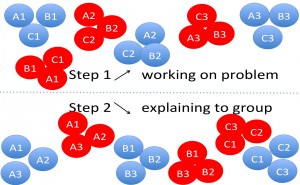
Using the “jigsaw” method for practicing solving problem-sets
A method to get all students engaged in solving problem sets.
A very common problem during problem-set solving sessions is that instead of all students being actively involved in the exercise, in each group there is one student working on the problem set, while the rest of the group is watching, paying more or (more likely) less attention. And here is what you can do to change that:
The jigsaw method (in German often called the “expert” method), you split your class into small groups. For the sake of clarity let’s assume for now that there are 9 students in your class; this would give you three groups with three students each. Each of your groups now get their own problem to work on. After a certain amount of time, the groups are mixed: In each of the new groups, you will have one member of each of the old groups. In these new groups, every student tells the other two about the problem she has been working on in her previous group and hopefully explains it well enough that in the end, everybody knows how to solve all of the problems.
This is a great method for many reasons:
- students are actively engaged when solving the problem in their first group, because they know they will have to be the expert on it later, explaining it to others who didn’t get the chance to work on this specific problem before
- in the second set of groups, everybody has to explain something at some point
- you, the instructor, get to cover more problem sets this way than if you were to do all of them in sequence with the whole group.
How do you make sure that everybody knows which group they belong to at any given time? A very simple way is to just prepare little cards which you hand out to the students, as shown below:
The system then works like this: Everybody first works on the problem with the number they have on their card. Group 1 working on problem 1, group 2 on problem 2, and so forth. In the second step, all the As are grouped together and explain their problems to each other, as are the Bs, the Cs, …
And what do I do if I have more than 9 students?
This works well with 16 students, too. 25 is already a lot – 5 people in each group is probably the upper limit of what is still productive. But you can easily split larger groups into groups of nine by color-coding your cards. Then all the reds work together, and go through the system described above, as do the blues, the greens, the yellows…

Jigsaw with 18 participants in 6 sub-groups of 9 students going through the system as described above
This is a method that needs a little practice. And switching seats to get all students in the right groups takes time, as does working well together in groups. But it is definitely worth the initial friction once people have gotten used to it!


A quick introduction to Cooperative Learning (summarizing Anja Møgelvang’s workshop) - Adventures in Oceanography and Teaching says:
[…] by presenting results from her (pandemic, hence online) PhD studies: There, they used the “jigsaw” method. Students belonged to “home groups” but from there pick topics they are most […]